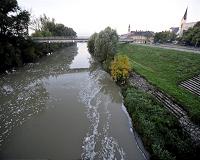 |
Columbia MO (SPX) Nov 05, 2010 Estimating the long-term impact of agriculture on land is tricky when you don't have much information about what a field was like before it was farmed. Some fields in Missouri started producing crops more than a century ago-long before anyone kept detailed records about the physical and chemical properties of the soil in a field. Researchers can't go back in time to revisit old fields in their pristine state, but a University of Missouri graduate student did perhaps the next best thing, using a detailed computer model to simulate, year-by-year, the effects of 100 years of farming on claypan soils. This can help determine the impact of certain conservation practices on farmland's crop yields and soil and water quality, said Ashish Mudgal, who recently completed his doctorate in soil science at MU. Mudgal took detailed measurements of the soil properties of two 80-acre claypan fields in Missouri-a never-farmed native prairie managed by MU and a field that had been under cultivation for more than a century and is currently managed by the USDA's Agricultural Research Service (ARS). These served as "before" and "after" snapshots to calibrate the model. He also made use of satellite images and aerial photographs taken between 1930 and 1990. Mudgal incorporated the data into a model developed by researchers at Texas A and M University called APEX (Agricultural Policy Environment eXtender). The simulation estimated changes in runoff, erosion, and the flow of sediment, nutrients and herbicides. After 100 simulated years of row-crop farming, the model showed an 82 percent increase in the average annual amount of the herbicide atrazine in runoff. Corn yields declined by 39 percent and soybean yields fell by 75 percent. "These results show that the restoration of agricultural lands would be beneficial not only to enhance crop yields but also to reduce nonpoint-source pollution," Mudgal said. The study also indicates that on claypan soils, the land that often causes the most environmental challenges when farmed tends to be less productive as well. Findings from simulations like this can help farmers, policymakers and conservation agents make informed decisions about best practices for managing farmland to reduce the environmental impact and enhance productivity. The study was funded in part by the USDA's Conservation Effects Assessment Project (CEAP), a long-range national effort to measure the impact of conservation practices and programs on agricultural land and water quality. Programs such as the USDA's Conservation Reserve Program provide farmers and ranchers financial incentives to retire areas of farmland for a certain length of time and/or implement conservation practices such as terraces, hedges of native grasses and plant buffers that filter nutrients, sediment and other pollutants from runoff. Conservation practices can't replace soil that has been lost over time, but they can return properties such as the soil's water infiltration capacity to something closer to the original state. Through studies such as Mudgal's, CEAP seeks to devise scientifically sound tools to gauge the effectiveness of conservation practices, which are designed to control erosion, maintain soil productivity, protect watersheds and enhance wildlife habitat. This can provide guidance for bringing retired land back into production and for targeting conservation efforts where they can do the most good, Mudgal said. Mudgal's faculty advisers were Claire Baffaut, an ARS research hydrologist based at MU, and Stephen Anderson, MU professor of soil science.
Share This Article With Planet Earth
Related Links University of Missouri-Columbia Farming Today - Suppliers and Technology
 Europe taking phosphates out of wash in water clean-up
Europe taking phosphates out of wash in water clean-upBrussels (AFP) Nov 4, 2010 Europe took steps Thursday to ban phosphates from laundry detergents in little over a year in a bid to clean up its rivers, lakes and marine waters. A European Commission proposal said the ban aimed to reduce phosphates found in waste water which, when discharged, can cause algae to grow at the expense of other aquatic life - a phenomenon known as "red tides" or "green tides" that scientist ... read more |
|
| The content herein, unless otherwise known to be public domain, are Copyright 1995-2010 - SpaceDaily. AFP and UPI Wire Stories are copyright Agence France-Presse and United Press International. ESA Portal Reports are copyright European Space Agency. All NASA sourced material is public domain. Additional copyrights may apply in whole or part to other bona fide parties. Advertising does not imply endorsement,agreement or approval of any opinions, statements or information provided by SpaceDaily on any Web page published or hosted by SpaceDaily. Privacy Statement |